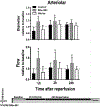The macrophage stimulating anti-cancer agent, RRx-001, protects against ischemia-reperfusion injury
- PMID: 28448172
- PMCID: PMC8051333
- DOI: 10.1080/17474086.2017.1324779
The macrophage stimulating anti-cancer agent, RRx-001, protects against ischemia-reperfusion injury
Abstract
Background: RRx-001, a clinical macrophage-stimulating anti-cancer agent that also produces nitric oxide (NO) was studied in a model of ischemia-reperfusion injury.
Methods: The production of NO is dependent on the oxygen tension because nitric oxide synthases convert l-arginine to NO and l-citrulline in the presence of O2. Since the P450 enzymes, which metabolize nitrate esters such as nitroglycerin are dependent on oxygen, the generation of 'exogenous' NO is also sensitive to alterations in tissue PO2. I/R injury was studied in a hamster chamber window, with compression of the periphery of the window for 1 h to induce ischemia. Animals received RRx-001 (5 mg/kg) 24 h before ischemia and sodium nitrite (10 nmols/kg) was supplemented 10 min after the start of reperfusion. Vessel diameter, blood flow, adherent leukocytes, and functional capillary density were assessed by intravital microscopy at 0.5, 2, and 24 h following the release of the ischemia.
Results: The results demonstrated that, compared to control, RRx-001 preconditioning increased blood flow and functional capillary density, and preserved tissue viability in the absence of side effects over a sustained time period.
Conclusion: Thus, RRx-001 may serve as a long-lived protective agent during postsurgical restoration of flow and other ischemia-reperfusion associated conditions, increasing blood flow and functional capillary density as well as preserving tissue viability in the absence of side effects.
Keywords: Ischemia-reperfusion injury; RRx-001; functional capillary density; nitric oxide; oncology.
Conflict of interest statement
Declaration of interest
B Oronsky is employed by EpicentRx. S Caroen is employed by EpicentRx. The authors have no other relevant affiliations or financial involvement with any organization or entity with a financial interest in or financial conflict with the subject matter or materials discussed in the manuscript apart from those disclosed.
Figures







Similar articles
-
Perfluorocarbon in microcirculation during ischemia reperfusion.J Am Coll Surg. 2007 Feb;204(2):225-35. doi: 10.1016/j.jamcollsurg.2006.11.007. Epub 2007 Jan 4. J Am Coll Surg. 2007. PMID: 17254926
-
Attenuation of postischemic reperfusion injury in striated skin muscle by diaspirin-cross-linked Hb.Am J Physiol. 1998 Aug;275(2):H361-8. doi: 10.1152/ajpheart.1998.275.2.H361. Am J Physiol. 1998. PMID: 9683421
-
Targeting tumor hypoxia with the epigenetic anticancer agent, RRx-001: a superagonist of nitric oxide generation.Med Oncol. 2016 Aug;33(8):85. doi: 10.1007/s12032-016-0798-9. Epub 2016 Jul 4. Med Oncol. 2016. PMID: 27377482
-
RRx-001: a systemically non-toxic M2-to-M1 macrophage stimulating and prosensitizing agent in Phase II clinical trials.Expert Opin Investig Drugs. 2017 Jan;26(1):109-119. doi: 10.1080/13543784.2017.1268600. Expert Opin Investig Drugs. 2017. PMID: 27935336 Review.
-
NO to cancer: The complex and multifaceted role of nitric oxide and the epigenetic nitric oxide donor, RRx-001.Redox Biol. 2015 Dec;6:1-8. doi: 10.1016/j.redox.2015.07.002. Epub 2015 Jul 2. Redox Biol. 2015. PMID: 26164533 Free PMC article. Review.
Cited by
-
A Review of RRx-001: A Late-Stage Multi-Indication Inhibitor of NLRP3 Activation and Chronic Inflammation.Drugs. 2023 Apr;83(5):389-402. doi: 10.1007/s40265-023-01838-z. Epub 2023 Mar 15. Drugs. 2023. PMID: 36920652 Free PMC article. Review.
-
Motion Blur Microscopy.bioRxiv [Preprint]. 2024 May 16:2023.10.08.561435. doi: 10.1101/2023.10.08.561435. bioRxiv. 2024. Update in: Nat Commun. 2024 Aug 16;15(1):7058. doi: 10.1038/s41467-024-51014-4. PMID: 37873474 Free PMC article. Updated. Preprint.
-
RRx-001 Radioprotection: Enhancement of Survival and Hematopoietic Recovery in Gamma-Irradiated Mice.Front Pharmacol. 2021 Apr 22;12:676396. doi: 10.3389/fphar.2021.676396. eCollection 2021. Front Pharmacol. 2021. PMID: 33967816 Free PMC article.
-
RRx-001 protects normal tissues but not tumors via Nrf2 induction and Bcl-2 inhibition.J Cancer Res Clin Oncol. 2019 Aug;145(8):2045-2050. doi: 10.1007/s00432-019-02958-4. Epub 2019 Jun 27. J Cancer Res Clin Oncol. 2019. PMID: 31250159 Free PMC article.
-
Platelet inhibitory effects of the Phase 3 anticancer and normal tissue cytoprotective agent, RRx-001.J Cell Mol Med. 2018 Oct;22(10):5076-5082. doi: 10.1111/jcmm.13791. Epub 2018 Jul 16. J Cell Mol Med. 2018. PMID: 30010241 Free PMC article.
References
-
- Toledo-Pereyra LH, Toledo AH, Walsh J, et al. Molecular signaling pathways in ischemia/reperfusion. Exp Clin Transplant. 2004;2:174–177. - PubMed
-
- Carden DL, Granger DN. Pathophysiology of ischaemia reperfusion injury. J Pathol. 2000;190:255–266. - PubMed
-
- Granger DN, Benoit JN, Suzuki M, et al. Leukocyte adherence to venular endothelium during ischemia-reperfusion. Am J Physiol. 1989;257:G683–688. - PubMed
-
- Schmid-Schonbein GW. Capillary plugging by granulocytes and the no-reflow phenomenon in the microcirculation. Fed Proc. 1987;46:2397–2401. - PubMed
-
- Inoue N, Ramasamy S, Fukai T, et al. Shear stress modulates expression of Cu/Zn superoxide dismutase in human aortic endothelial cells. Circ Res. 1996;79:32–37. - PubMed
MeSH terms
Substances
Grants and funding
LinkOut - more resources
Full Text Sources
Other Literature Sources
